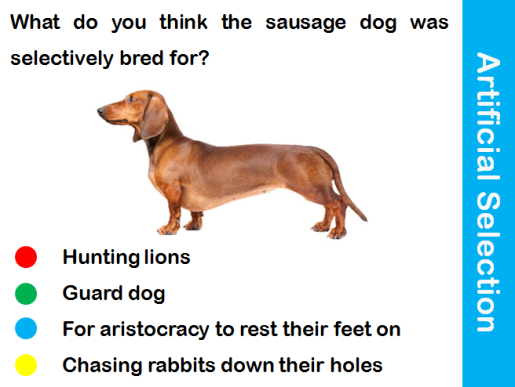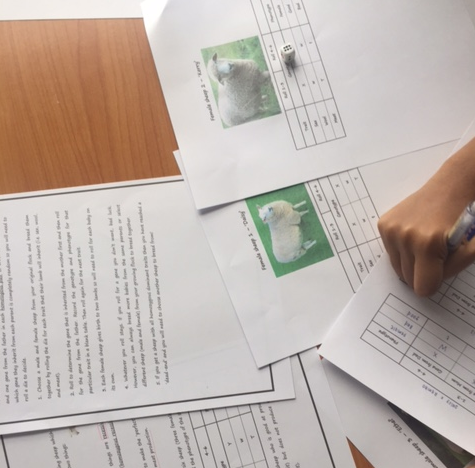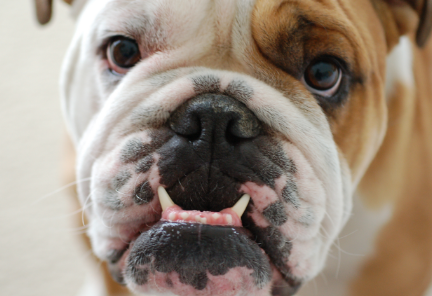Artificial selection is the process by which humans select animals and plants for breeding because of their useful characteristics e.g. high crop yield in cereal crops and meat quantity and quality in beef cattle. Artificial selection has been practiced for thousands of years to produce varieties of animals and plants with increased economic importance. At GCSE, students may not only be required to define the process of artificial selection (or selective breeding as it is also known) but also state the similarities and differences between natural and artificial selection, and outline the steps involved in ‘improving’ crop plants and domesticated animals over many generations.
I would actually suggest introducing artificial selection before broaching (or revisiting) natural selection, as students often find it easier to grasp the concept of humans acting as the selective agent, purposively picking and choosing which individuals survive to breed, than the environment. There are also many examples of weird and wonderful selectively-bred plants and animals with which the students will already be familiar. Indeed, I tend to open the lesson with a short quiz in which I display photographs of sausage dogs, Merino sheep, Belgian blue cows etc., and ask the students to guess why they look the way that they do.

Thinking Maps
However, once the students are familiar with both artificial and natural selection, it is useful to compare and contrast the two using a card sort activity, Venn diagram or double-bubble map. The students should identify that both processes require genetic variation and result in individuals with particular phenotypic traits (characteristics) surviving to breed and pass on their genes, while others do not. At this stage it may also be useful to reinforce the concept of evolution as being a change in frequency of particular alleles within a population over time and that, as such, evolution occurs through artificial as well as natural selection (one common misconception is that natural selection and evolution are one and the same).
Selective Breeding Game
This is a fun game in which the students, as farmers, aim to selectively breed sheep with both plentiful wool and high quality meat. It is a particularly effective activity for demonstrating that artificial selection occurs over successive generations and that the farmer does not actually create anything (the alleles for the favourable characteristics already exist) but simply decides which individuals can breed and which can not. The game is available to download for free here.

Wolf and Dog Handraising Project
This is a BBC documentary entitled ‘The Secret Life of the Dog’ which features an overview of a fascinating experiment carried out by researchers at Eötvöus Loránd University in Hungary between 2001 – 2003. The aim of the experiment was to investigate whether the relationship between humans and domesticated dogs could be replicated with wolf cubs if they were treated like puppies and raised in the home. It makes for a fantastic discussion point about ‘nature and nurture’ by highlighting the fact that artificial selection can result in changes to an animal’s temperament as well as their appearance. The relevant section begins at 32 minutes in.
The Ethics of Artificial Selection
The danger of artificial selection is that that there may be too much inbreeding between closely related individuals. This can result in harmful recessive alleles being inherited alongside the desired genes, and an overall reduction in genetic variation. Indeed, many breeds of dog suffer from the effects of inbreeding e.g. elbow and hip dysplasia, epilepsy and heart disease (further information is available from the Kennel Club, among other sources). Asking students to consider the ethics of artificial selection, can prove an engaging topic for debate, if carefully structured.

Really nice post, thank you. I’m going to pinch some ideas for my )home-schooled) eldest. You may already know, but there was a long-running experiment in Russia showing the effect of selective breeding on arctic foxes: http://blogs.discovermagazine.com/d-brief/2016/09/14/russian-experiment-breeds-domesticated-foxes/#.WIfd2lOLTIU
LikeLike
Thank you very much Ian. Yes, the arctic fox breeding programme is also featured in the same documentary but I will most definitely take a look at the link you have sent me. Thanks again
LikeLike
Hello! Thank you so much for this great site. However, I cannot find the link to the Selective Breeding Game. HELP!
LikeLike
Hi Lisa, is it this one? https://ifitsgreenormoves.com/resources/
If you click on the image it will take your directly to the resource. Any problems, let me know 🙂
LikeLike